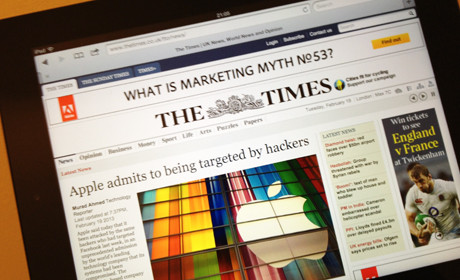
As the number of mobile devices increases, so do the platforms on which readers access a news outlet's content.
And The Times and The Sun, which both charge readers for access in print and online, track subscribers as they read on a phone, via tablet app or on desktop.
Chris Duncan, customer sales director at News UK, which owns The Sun and The Times, told the Mobile Media Strategies conference taking place in London today how user data is collected and collated.
He did not reveal subscriber numbers but did share insights into customer behaviours and explain how they encourage new sign ups and retain existing customers.
New subscribers
Duncan said that 67 per cent of sales are now completed on mobile devices, with a 50:50 split between those signing up on a smartphone and those using a tablet.
News UK "invested heavily in owning data", Duncan said, in order to monitor subscribers to The Times and now to The Sun, which put up a paywall last month.
Once a subscriber signs up, they get a subscriber ID. Sun and Times customers are kept separate, so if an individual signs up to two newspapers they have two subscriber identities.
The habits of new customers are tracked for 14 days. They are then monitored so the publisher can spot anyone who is not using the digital package regularly, which suggests their subscription will lapse.
Subscriber retention
The publisher looks at dwell time and reader journeys across apps and webpages and gets "a granular level" of data on user behaviour.
They are able to see which content drives people to subscribe, and which content people read over the long-term. Both columnists and the crossword have been found to be types of content people return to regularly, retaining their interest and therefore subscription.The more devices people use, the less likely they are to churnChris Duncan, News UK
The Sun and The Times "actively encourage people to use as many devices as possible," Duncan said.
They have found the "best customers are using multiple devices". Each time someone adds a new device and uses it to read The Times, the "churn rate", or chance of them cancelling their subscription, reduces by four points.
"The more devices people use, the less likely they are to churn," Duncan said.
Tracking customer engagement in this way allows The Times – and now The Sun – spot if readers are likely to cancel a subscription. If they see dwell time reducing, "they are at risk of churn"
"The earlier we notice, the more likely it is we can retain those customers," Duncan said.
And it is paid subscriber numbers that are considered the most important metric. "Pageviews used to be the drug of choice," Duncan said, but now it is paid sales.
The outlet also looks at “broken journeys”, when people exit the app or site. The experience on mobile is often not as smooth as it should be, Duncan said, explaining they have identified 107 different reasons for such abandoned journeys. If two thirds of new subscribers are coming from a mobile route, it is important to get right, he said.
Mobile lessons
Tablets provide a "print replacement", with the benefit of getting return visits in the evening, especially from people who have read the front pages in the morning and returning to access lifestyle content after the work day.
The Times and The Sun have also learned lessons in how people use mobile phones to access their content. They have found that newsletter bulletins sent by email then result in a rise in traffic from mobile.
"We are seeing an increasingly high correlation between sending an email and then a mobile traffic spike," Duncan said.
The same is true of push notifications within the apps. The Sun's new Goals app, available as part of the digital package, uses such notifications to encourage engagement.
Free daily newsletter
If you like our news and feature articles, you can sign up to receive our free daily (Mon-Fri) email newsletter (mobile friendly).









